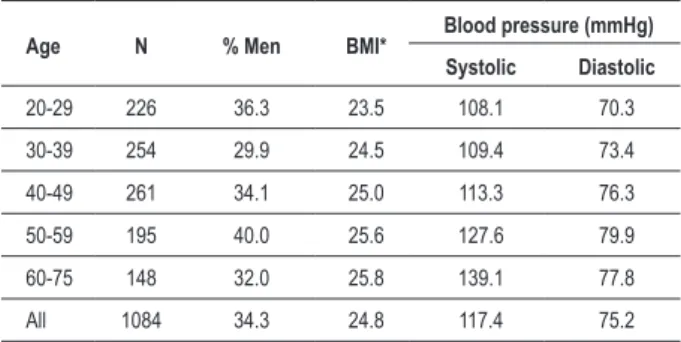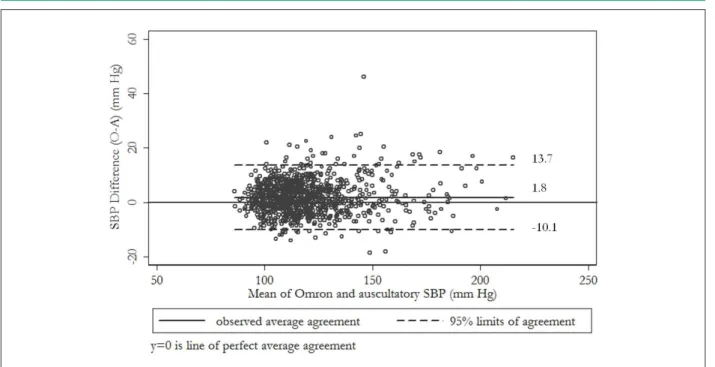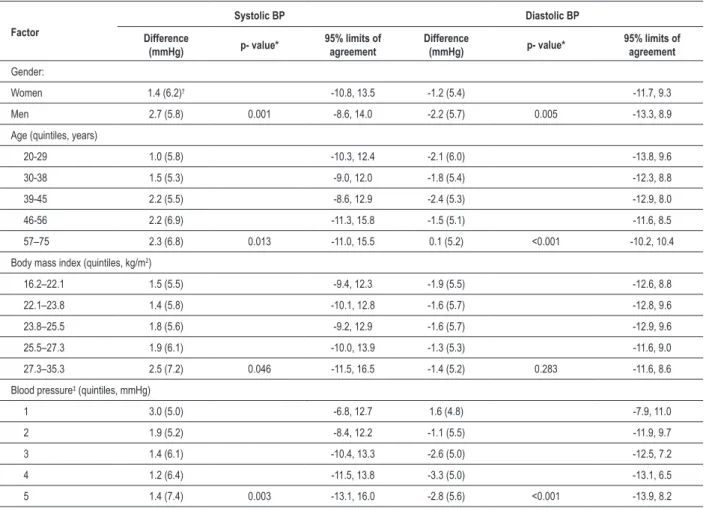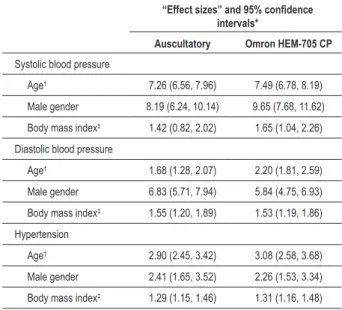Accuracy of the Omron HEM-705 CP for Blood Pressure
Measurement in Large Epidemiologic Studies
Lina M. Vera-Cala
1,2, Myriam Orostegui
1, Laura I. Valencia-Angel
1, Nahyr López
1, Leonelo E. Bautista
2Departamento de Salud Pública, Universidad Industrial de Santander1, Bucaramanga - Colombia, Department of Population Health Sciences, University of Wisconsin, School of Medicine and Public Health2, Madison - USA
Mailing address: Lina Vera-Cala •
610 N Walnut Street, WARF Building Room 626, Madison, Wisconsin, 53705 - USA
E-mail: veracala@wisc.edu
Manuscript received February 17, 2010; revised manuscript received October 07, 2010; accepted November 30, 2010.
Abstract
Background: Accurate measurement of blood pressure is of utmost importance in hypertension research. In the context of epidemiologic and clinical studies, oscillometric devices offer important advantages to overcome some of the limitations of the auscultatory method. Even though their accuracy has been evaluated in multiple studies in the clinical setting, there is little evidence of their performance in large epidemiologic studies.
Objective: We evaluated the accuracy of the Omron HEM-705-CP, an automatic device for blood pressure (BP) measurement, as compared to the standard auscultatory method with a mercury sphygmomanometer in a large cohort study.
Methods: We made three auscultatory measurements, followed by two measurements with the Omron device in 1084 subjects. Bias was estimated as the average of the two Omron minus the average of the last two auscultatory measurements, with its corresponding 95% limits of agreement (LA).
Results: The Omron overestimated systolic blood pressure (SBP) by 1.8 mmHg (LA:-10.1, 13.7) and underestimated diastolic blood pressure (DBP) by 1.6 mmHg (LA:-12.3, 9.2). Bias was significantly larger in men. Bias in SBP increased with age and decreased with BP level, while bias in DBP decreased with age and increased with BP level. The sensitivity and specificity of the Omron to detect hypertension were 88.2% and 98.6%, respectively. Minimum bias in the estimates of the effects of several factors resulted from the use of Omron measurements.
Conclusion: Our results showed that the Omron HEM-705-CP could be used for measuring BP in large epidemiology studies without compromising study validity or precision. (Arq Bras Cardiol 2011;96(5):393-398)
Keywords: Blood pressure; measurement equipment; clinical trials; epidemiologic studies.
the potential for observer bias. However, the performance of oscillometric devices has been variable and it is recognized that each device should be evaluated in the context and population in which it is to be used1-5. The accuracy of oscillometric devices has been evaluated in multiple studies in the clinical setting, but there is little evidence of their performance in large epidemiologic studies.
The objective of this study was to evaluate the accuracy of the Omron HEM-705 CP oscillometric device as compared to the standard auscultatory method with a mercury sphygmomanometer in the context of a large epidemiologic study.
Methods
This study was nested within the Incidence of Cardiovascular Diseases and their Risk Factors (INEFAC) Study, a cohort study of a random sample of 15-64-year-old individuals from Bucaramanga, Colombia (n = 1,634). We used data from 1,084 subjects with an arm circumference between 25 and 32 cm who
completed a first follow-up evaluation (≈ 6 years) and had both
auscultatory and oscillometric measurements of blood pressure. The blood pressure measurements were conducted between 6:00 and 9:00 AM and participants refrained from smoking
Introduction
and exercising for the 12 hours prior to the exam. Following the guidelines from the American Hearth Association6, all measurements were conducted after five minutes of rest, with the participant comfortably seated, with his/her feet straight upon the ground and the back and arm supported, and with the antecubital fossa at the level of the heart. The maximum cuff inflation was calculated by adding 30 mmHg to the pulse obliteration pressure, and the cuff was deflated at a constant rate of 2 to 4 mm per second. All observers received 40 hours of training at the beginning of the study and then they were certified every 3-4 months. They were closely supervised by a trained physician in order to assure adherence to the study protocol. Blood pressure data were periodically analyzed for quality control purposes and to detect and correct potential deviations from the protocol. Two independent observers made three auscultatory blood pressure measurements in each participant, followed by two additional measurements with the Omron HEM-705 CP taken by a third observer. The average of the last two auscultatory and the two oscillometric measurements were used in the analysis.
The accuracy of the oscillometric device was evaluated using the protocol criteria defined by the British Hypertension Society (BHS)2,4 and the American Association for the Advancement of Medical Instrumentation (AAMI)2,7 for validating blood pressure measuring devices. Bias was estimated as the mean of the two Omron HEM-705 CP measurements minus the mean of the last two auscultatory measurements, with its corresponding 95% limits of agreement (LA), as defined by Bland and Altman8. We also calculated the size of the bias in groups of participants defined by characteristics known to be associated with blood pressure (gender, age, body mass index) and used receiver operator curves to estimate the validity of Omron HEM-705 CP in identifying participants
with hypertension (systolic blood pressure ≥ 140 mmHg or diastolic blood pressure ≥ 90 mmHg). Finally, we used linear
and logistic regression to estimate and compare the magnitude of the effects of age, gender, and body mass index on blood pressure and hypertension when using oscillometric and auscultatory measures.
Results
Overall, slightly above a third of the sample were men (n = 372; Table 1) and the average age was 42.5 years (95% confidence interval - 95%CI: 41.7, 43.3). The average systolic and diastolic blood pressure measured with the auscultatory method were 117.4 (95% CI: 116.2, 118.5) and 75.2 (95% CI: 74.6, 75.8) mmHg, respectively. A total of 199 individuals
(18.4%; 95% CI: 16.0, 20.7) were hypertensive (systolic ≥ 140 and/or diastolic ≥ 90 mmHg or taking antihypertensive
medication); 114 (10.5%) were receiving antihypertensive medication; and 149 (13.7%) had blood pressure values within the hypertensive range. Mean body mass index, waist circumference, hip circumference were 24.8 kg/m2, 77.0 cm, and 95.5 cm, respectively.
The difference between the oscillometric and auscultatory
blood pressure values were ≤ 15 mmHg in 97.5% of the
times for systolic and in 99.5% of the times for diastolic blood
pressure; ≤ 10 mmHg in 90.6% of the times for systolic
and in 93.5% of the times for diastolic blood pressure; and
≤ 5 mmHg in 64.0% of the times for systolic and 63.7% of
the times for diastolic blood pressure. The average of the oscillometric systolic blood pressure measures (119.2 mmHg) was 1.8 mmHg higher than the average of auscultatory measures (117.4 mmHg; p < 0.001; Table 2). In contrast, the average of the oscillometric diastolic blood pressure measures (73.7 mmHg) was 1.6 mmHg lower than the average of the auscultatory measures (75.2 mmHg; p < 0.001). The difference between the systolic blood pressure measurements by the two methods for each subject has been plotted against their mean in Figure 1A9. This figure shows that both the variability and the size of the bias were unrelated to the mean systolic blood pressure. Moreover, according to the estimated limits of agreement in 95% of the times the differences between future measures with the two methods in a new individual will lie within -10.1 to 13.7 mmHg. Similarly, Figure 1B shows no pattern in the size and variability of the bias in diastolic blood pressure values as related to the average of both methods. Moreover, 95% of the differences between future pairs of diastolic blood pressure measurement using these two methods are expected to lie within -12.3 to 9.6 mmHg.
The bias in the oscillometric measurements was about 1 mmHg larger in men than in women for both systolic and diastolic blood pressures (Table 3). The bias in systolic blood pressure also seemed to increase with age, but there was no clear age-related pattern for the bias in diastolic blood pressure. Similarly, the bias increased significantly with body mass index for systolic, but not for diastolic blood pressure. Finally, the bias in systolic blood pressure decreased, while the bias in diastolic blood pressure increased with quintiles of corresponding blood pressure values.
Table 1 -Average body mass index and blood pressure, and percentage of men by age group
Age N % Men BMI* Blood pressure (mmHg) Systolic Diastolic
20-29 226 36.3 23.5 108.1 70.3
30-39 254 29.9 24.5 109.4 73.4
40-49 261 34.1 25.0 113.3 76.3
50-59 195 40.0 25.6 127.6 79.9
60-75 148 32.0 25.8 139.1 77.8
All 1084 34.3 24.8 117.4 75.2
*Body mass index (kg/m2).
Table 2 - Mean systolic and diastolic blood pressure and corresponding standard deviations (SD) by measurement method
Blood pressure
(mmHg)
Method
Bias 95% CI** Auscultatory Oscillometric*
Systolic 117.4 (19.0) 119.2 (19.5) 1.8 (1.5, 2.2)
Diastolic 75.2 (9.9) 73.7 (9.9) -1.6 (-1.9, -1.2)
As compared to the auscultatory method, the Omron HEM-705 CP had a sensitivity of 81.9% (95% CI: 74.7, 87.8) and a specificity of 97.6% (95% CI: 96.4, 98.4) to detect individuals with blood pressure values in the hypertensive
range (systolic blood pressure ≥ 140 mmHg and/or diastolic blood pressure≥ 90 mmHg). Sensitivity and specificity to
detect individuals with hypertension (blood pressure values within the hypertensive range and/or receiving pharmacologic treatment) were 88.2% (95% CI: 82.8, 92.4) and 98.6% (95%
CI: 97.6, 99.30), respectively. Moreover, the proportion of individuals correctly classified according to their hypertensive status based only on blood pressure values was 95.2% and the area under the receiver operator characteristics curve was 0.89 (95% CI, 0.86 to 0.92).
Using measurements obtained with the Omron HEM 705 CP device, as compared to the auscultatory method, resulted in slightly biased, but similarly precise estimates of the effect of age, gender, and body mass index on blood pressure (Table
Figure 1A - Systolic blood pressure (SBP): difference between Omron and auscultatory (O-A) values versus average of values.
Table 3 -Differences between oscillometric (Omron HEM-705 CP) and auscultatory blood pressure values and 95% limits of agreement by factors associated to blood pressure level
Factor
Systolic BP Diastolic BP
Difference
(mmHg) p- value* 95% limits of agreement
Difference
(mmHg) p- value* 95% limits of agreement
Gender:
Women 1.4 (6.2)† -10.8, 13.5 -1.2 (5.4) -11.7, 9.3
Men 2.7 (5.8) 0.001 -8.6, 14.0 -2.2 (5.7) 0.005 -13.3, 8.9
Age (quintiles, years)
20-29 1.0 (5.8) -10.3, 12.4 -2.1 (6.0) -13.8, 9.6
30-38 1.5 (5.3) -9.0, 12.0 -1.8 (5.4) -12.3, 8.8
39-45 2.2 (5.5) -8.6, 12.9 -2.4 (5.3) -12.9, 8.0
46-56 2.2 (6.9) -11.3, 15.8 -1.5 (5.1) -11.6, 8.5
57–75 2.3 (6.8) 0.013 -11.0, 15.5 0.1 (5.2) <0.001 -10.2, 10.4
Body mass index (quintiles, kg/m2)
16.2–22.1 1.5 (5.5) -9.4, 12.3 -1.9 (5.5) -12.6, 8.8
22.1–23.8 1.4 (5.8) -10.1, 12.8 -1.6 (5.7) -12.8, 9.6
23.8–25.5 1.8 (5.6) -9.2, 12.9 -1.6 (5.7) -12.9, 9.6
25.5–27.3 1.9 (6.1) -10.0, 13.9 -1.3 (5.3) -11.6, 9.0
27.3–35.3 2.5 (7.2) 0.046 -11.5, 16.5 -1.4 (5.2) 0.283 -11.6, 8.6
Blood pressure‡ (quintiles, mmHg)
1 3.0 (5.0) -6.8, 12.7 1.6 (4.8) -7.9, 11.0
2 1.9 (5.2) -8.4, 12.2 -1.1 (5.5) -11.9, 9.7
3 1.4 (6.1) -10.4, 13.3 -2.6 (5.0) -12.5, 7.2
4 1.2 (6.4) -11.5, 13.8 -3.3 (5.0) -13.1, 6.5
5 1.4 (7.4) 0.003 -13.1, 16.0 -2.8 (5.6) <0.001 -13.9, 8.2
*Test for trend from a linear regression model; † Standard deviation; ‡Quintile values for systolic blood pressure are: 84-103; 104-110; 111-117; 118-129 mmHg; and 130–211; quintile values for diastolic blood pressure are: 46-67; 68-72; 73-77; 77.5-83; and 83.5-124 mmHg.
4). When diastolic and systolic blood pressure were used as continuous variable in a linear regression model, the bias in the effect of the above mentioned variables was always less than 2 mmHg. Similarly, a logistic regression model with hypertension as the outcome showed that the bias in
the estimates of the odds ratios for these variables was ≤
6%. Moreover, the confidence intervals for the estimates of the effects of these variables were of similar width for the auscultatory and oscillometric measurements.
Discussion
Our results showed that the Omron HEM 705 CP overestimated systolic blood pressure by 1.8 mmHg and underestimated diastolic blood pressure by 1.6 mmHg, when compared with the auscultatory method using a mercury sphygmomanometer. Although statistically significant, these differences are very small and should have little impact in the clinical setting or in epidemiologic studies. Our results are consistent with those of some10,11, but not all studies on other Omron devices12-15. We also found that the Omron HEM-705 CP qualifies as a grade A device for measuring
blood pressure, according to the BHS protocol criteria1,2. This finding is consistent with those from most previous studies on this device conducted in clinical settings with selected groups of patients16-18.
Previous studies on the Omron HEM-705 CP device have not reported how the bias in blood pressure measurements is related to patient’s characteristics. In this study, we found that the bias in systolic blood pressure measurements was larger in men than in women, increased with age and with body mass index, but decreased with higher levels of systolic blood pressure. In contrast, the bias in diastolic blood pressure measurements was larger in men, was not associated with age or body mass index, and decreased with higher levels of diastolic blood pressure. In spite of the systematic pattern in the Omron HEM-705 CP errors, the magnitude of the bias was small, less than 3 mmHg in almost all patient groups. Although other devices have shown an increment in the size of the bias in obese people for both systolic and diastolic blood pressure10, our results only support this increment for systolic blood pressure.
Table 4 -Association between age, gender and body mass index with systolic blood pressure, diastolic blood pressure and hypertension using auscultatory and oscillometric measurements
“Effect sizes” and 95% conidence
intervals*
Auscultatory Omron HEM-705 CP
Systolic blood pressure
Age† 7.26 (6.56, 7.96) 7.49 (6.78, 8.19)
Male gender 8.19 (6.24, 10.14) 9.65 (7.68, 11.62)
Body mass index‡ 1.42 (0.82, 2.02) 1.65 (1.04, 2.26)
Diastolic blood pressure
Age† 1.68 (1.28, 2.07) 2.20 (1.81, 2.59)
Male gender 6.83 (5.71, 7.94) 5.84 (4.75, 6.93)
Body mass index‡ 1.55 (1.20, 1.89) 1.53 (1.19, 1.86)
Hypertension
Age† 2.90 (2.45, 3.42) 3.08 (2.58, 3.68)
Male gender 2.41 (1.65, 3.52) 2.26 (1.53, 3.34)
Body mass index‡ 1.29 (1.15, 1.46) 1.31 (1.16, 1.48)
* For systolic and diastolic blood pressure the “effect size” corresponds to the change in blood pressure (mmHg) per unit change in the variable, while adjusting for the other variables. For hypertension the “effect size” is the multivariable adjusted odds ratio per unit change in the variable; † Change for 10 years of age; ‡ Change for 2 kg/m2 of body mass index.
Omron HEM-705 CP in this context would result in a slight underestimate of the prevalence of hypertension (18.4% if the actual prevalence is 20% and 27.1% if the actual prevalence is 30%). More important, using the Omron HEM-705 CP will result in little bias in the estimates of the effect of risk factors related to blood pressure and hypertension. Particularly, the degree of bias in the estimates of the odds ratios for known risk factors would likely be lower than the traditional 10% change in estimates used to identify important confounders19.
In conclusion, our results showed that the Omron HEM-705 CP device could be used for measuring blood pressure and detecting hypertension in large epidemiologic studies without compromising study validity or precision.
Acknowledgments
To COLCIENCIAS and Universidad Industrial de Santander for the grant to conduct the INEFAC study.
Potential Conflict of Interest
No potential conflict of interest relevant to this article was reported.
Sources of Funding
This study was funded by COLCIENCIAS e UIS.
Study Association
This study is not associated with any post-graduation program.
References
1. Gillman MW, Cook NR. Blood pressure measurement in childhood epidemiological studies. Circulation. 1995;92(4):1049-57.
2. O’Brien E, Atkins N. A comparison of the British Hypertension Society and Association for the Advancement of Medical Instrumentation protocols for validating blood pressure measuring devices: can the two be reconciled? J Hypertens. 1994;12(9):1089-94.
3. Beevers DG, Beevers M. Blood pressure measurement: worsening chaos. J Hum Hypertens. 2000;14(7):415-6.
4. O’Brien E, Waeber B, Parati G, Staessen J, Myers MG. Blood pressure measuring devices: recommendations of the European Society of Hypertension. BMJ. 2001;322(7285):531-6.
5. Ni H, Wu C, Prineas R, Shea S, Liu K, Kronmal R, et al. Comparison of Dinamap PRO-100 and mercury sphygmomanometer blood pressure measurements in a population-based study. Am J Hypertens. 2006;19(4):353-60.
6. Pickering TG, Hall JE, Appel LJ, Falkner BE, Graves J, Hill MN, et al. Recommendations for blood pressure measurement in humans and experimental animals: part 1: blood pressure measurement in humans: a statement for professionals from the subcommittee of professional and public education of the American Heart Association Council on High Blood Pressure Research. Circulation. 2005;111(5):697-716.
7. White WB, Berson AS, Robbins C, Jamieson MJ, Prisant LM, Roccella E, et al. National standard for measurement of resting and ambulatory blood pressures with automated sphygmomanometers. Hypertension. 1993;21(4):504-9.
8. Bland JM, Altman DG. Statistical methods for assessing agreement between two methods of clinical measurement. Lancet. 1986;1(8476):307-10.
9. Bland JM, Altman DG. Measuring agreement in method comparison studies. Stat Methods Med Res. 1999;8(2):135-60.
10. Altunkan S, Ilman N, Kayaturk N, Altunkan E. Validation of the Omron M6 (HEM-7001-E) upper-arm blood pressure measuring device according to the International Protocol in adults and obese adults. Blood Press Monit. 2007;12(4):219-25.
11. Grim CE, Grim CM. Omron HEM-711 DLX home Blood pressure monitor passes the European Society of Hypertension International Validation Protocol. Blood Press Monit. 2008;13(4):225-6.
12. Rotch AL, Dean JO, Kendrach MG, Wright SG, Woolley TW. Blood pressure monitoring with home monitors versus mercury sphygmomanometer. Ann Pharmacother. 2001;35(7-8):817-22.
13. Omboni S, Riva I, Giglio A, Caldara G, Groppelli A, Parati G. Validation of the Omron M5-I, R5-I and HEM-907 automated blood pressure monitors in elderly individuals according to the International Protocol of the European Society of Hypertension. Blood Press Monit. 2007;12(4):233-42.
14. Coleman A, Steel S, Freeman P, de Greeff A, Shennan A. Validation of the Omron M7 (HEM-780-E) oscillometric blood pressure monitoring device according to the British Hypertension Society protocol. Blood Press Monit. 2008;13(1):49-54.
15. Lewis JE, Boyle E, Magharious L, Myers MG. Evaluation of a community-based automated blood pressure measuring device. CMAJ. 2002;166(9):1145-8. individuals with hypertension and 99% of those without
16. Iglesias Bonilla P, Mayoral Sánchez E, Lapetra Peralta J, Iborra Oquendo M, Villalba Alcalá F, Cayuela Dominguez A. Validation of two systems of self-measurement of blood pressure, the OMRON HEM-705 CP and OMRON M1 (HEM 422C2-E) models. Aten Primaria. 2002;30(1):22-8.
17. O’Brien E, Mee F, Atkins N, Thomas M. Evaluation of three devices for self-measurement of blood pressure according to the revised British Hypertension Society Protocol: the Omron HEM-705CP, Philips HP5332, and Nissei DS-175. Blood Press Monit. 1996;1(1):55-61.
18. Furusawa EA, Ruiz MF, Saito MI, Koch VH. Evaluation of the Omron 705-CP blood pressure measuring device for use in adolescents and young adults. Arq Bras Cardiol. 2005;84(5):367-70.



